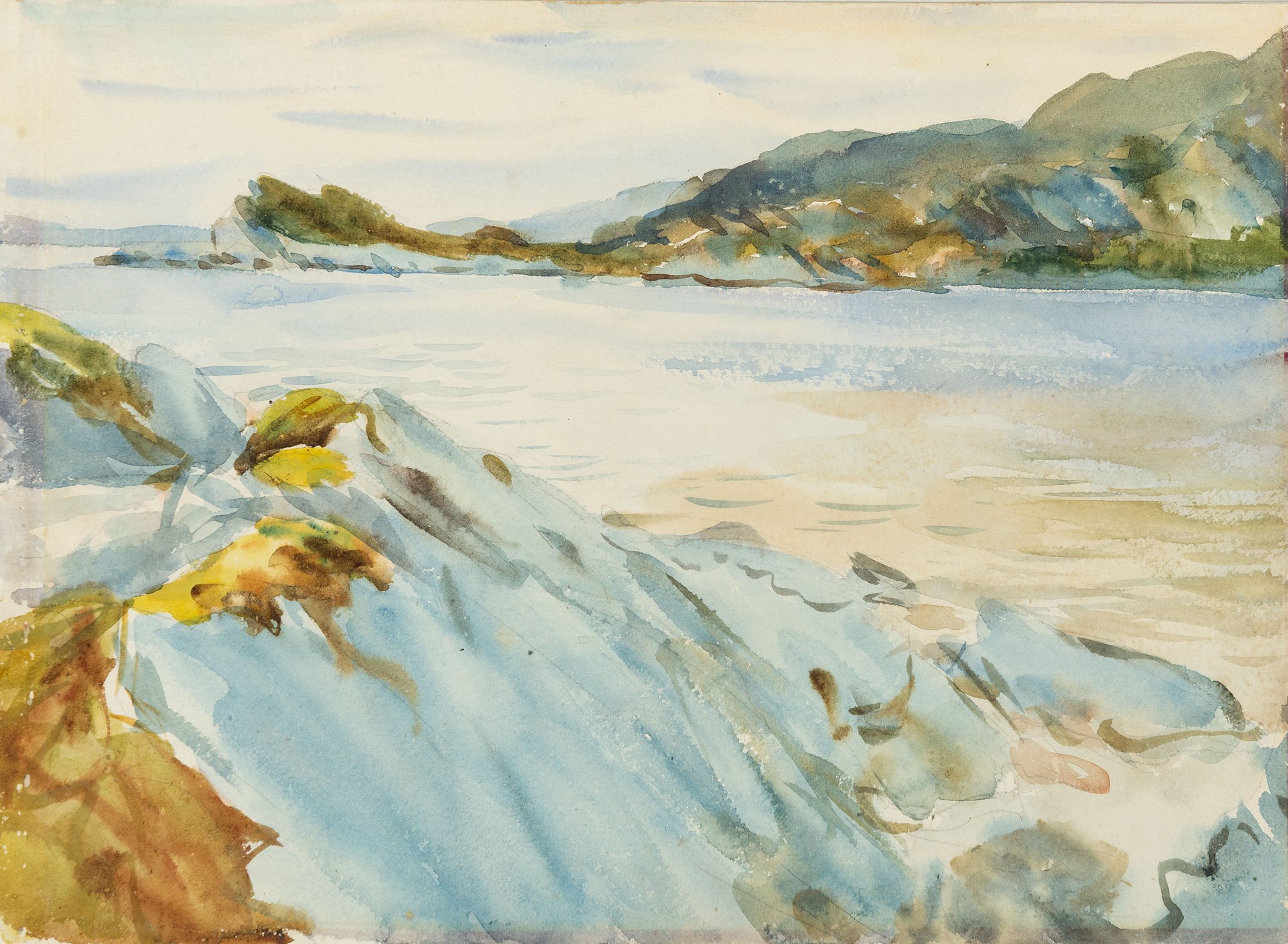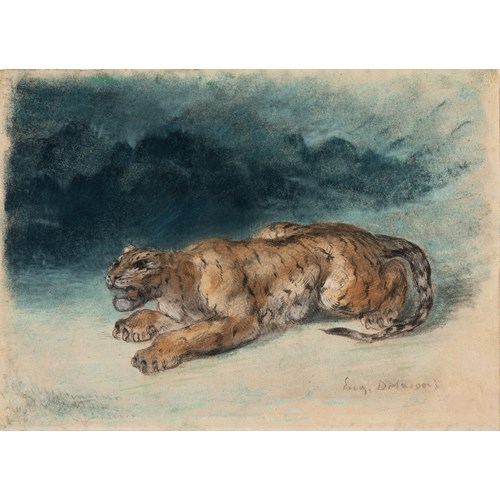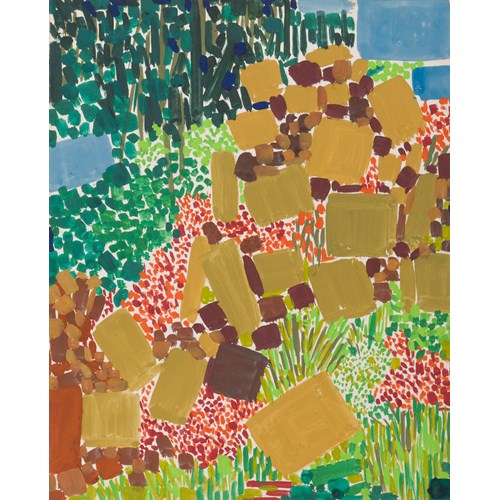Sargent’s watercolours were, for the most part, private works done on his extensive travels in Europe, North Africa and the Middle East, and they served as a welcome respite from the portraits done in his studio. As the artist wrote in a letter of 1909 to a friend, ‘I have an entirely different feeling for sketches and studies than I have for portraits…sketches from nature give me pleasure to do + pleasure to keep + more than the small amount of money that one could ask for them.’ His virtuoso technique as a watercolourist is readily evident in these spirited works, which allowed the artist a particular freedom of expression, heightened by the necessary speed of execution.
One scholar has written of Sargent’s watercolours that ‘Restricting his palette to six or seven colors and using a fistful of brushes, he would work on damp paper, spreading washes of color to the edges of the paper and using Chinese white (gouache) and the white paper to create highlights. His two primary hues were ultramarine blue and sienna brown, and with these colors he was able to create extraordinary effects. By varying the intensity and value of these colors he achieved tonal harmonies that at first glance seem Impressionist, but it was a plein-air approach, with broad washes highlighted with dashes of color and light that enlivened the surface.’
Sargent made two visits to the west coast of Scotland, in the summer and autumn of 1896 and 1897, both times staying with his friend, the obstetrician Dr. William Playfair, his wife Emily (known as Milly) and their family. The present sheet was executed on the first of these two visits, when the artist was a guest of the Playfairs on the island of Eilean Shona, situated at the entrance to Loch Moidart in the Inner Hebrides and only accessible by boat. As Dr. Playfair recorded, in an unpublished autobiography, ‘[In 1893] we spent our holidays in Scotland in a particularly lovely place. Eilean Shona is situated in the middle of Loch Moidart; there is a good family house on the island and we enjoyed our holiday to the full. A more beautiful setting cannot be imagined and we returned on three further occasions…On the last occasion that we went there J. S. Sargent came with us and, during his stay, he painted three water colours of Loch Moidart for Milly. They remind us of some of our happiest times as a family is Scotland.’ As Lilias, one of the Playfair daughters, recalled many years later, ‘we have three sketches he did (among many) when he stayed with us at Eilean Shona Moidart…They were painted in 1896 & given to my mother as Xmas presents, in three successive years. He generally dined with us on Xmas day…’ The two other watercolour views of Loch Moidart that were once in the Playfair collection are today in private collections.
In their magisterial catalogue raisonné of Sargent’s oeuvre, Richard Ormond and Elaine Kilmurray note that ‘The three water-colours that Sargent gave to Emily Playfair…are all of a piece. They are painted from the rocky shoreline of Eilean Shona across narrow passages of water to hills and headlands. They are like separate frames from a scenic panorama, recording different facets of an all-embracing view. Tonally, they match one another, with their fresh blues set off by browns, mauves, and greens…[The present sketch of Loch Moidart] was probably painted looking toward the western end of the island…The foreground slab of rock reflects the blue light from the water, and it is topped by brown seaweed. The colour of the open stretch of water beyond is predominantly pale blue and grey green. The brown tone of the seaweed is picked up in the earth colours of the headland spur, and this gives way to a pale blue sky. Though the day is seemingly overcast, the water-colour conveys the translucent atmosphere of the place in clear, crisp tones.’
Two other watercolours thought to depict Loch Moidart, of vertical format, are in the collection of the Metropolitan Museum of Art in New York, while a handful of other watercolours, some now untraced, have also been associated with this period of Sargent’s career. The watercolours produced by Sargent in Scotland were, however, the last significant watercolours that he was to paint in Britain.
Ormond and Kilmurray have written extensively of the artist’s Scottish watercolours: ‘In them, he charts the constantly shifting weather, the movement of the sea, and the fleeting patterns of light on rocks and water. The brush flickers over the surface, creating the sense of a landscape alive and in flux. He also captures that pearly, translucent quality of light you find in the west of Scotland in the way that he manipulates the clear tones and the wet washes of his medium. Sargent was refining his technique and developing that breadth of effect and fluency of the medium that would amaze his contemporaries in the period after 1900. His habit of isolating fragments of landscape, of seizing a motif in close-up to the exclusion of everything else, are very much in evidence in his Scottish water-colours. He was forging a new style that was altogether bolder and more exuberant than anything he had painted before…The water-colours that Sargent painted in Scotland point the way to the plein-air studies he was to paint in Europe post-1900. In his spirited use of the water-colour medium and his keen eye for the vagaries of light and weather, he anticipates the themes of his mature landscape work.’
Provenance: Presented by the artist, probably in 1898, to Emily (Mrs. William) Playfair, London
By descent to her daughters Lilias (Lilian) Playfair, Chelsea, and Edith Playfair (Mrs. William Arthur Price), Hampstead, in 1916
By descent to Edith Playfair Price’s daughters Penelope Rose Price (Mrs. Harold Allan Stanier) and Edith Mary Price, in 1956
Anonymous sale, London, Sotheby’s, 4 November 1992, lot 15
Anonymous sale, London, Christie’s, 23 November 1993, lot 70
Private collection
Private collection, New York.
Literature: William Howe Downes, John S. Sargent: His Life and Work, with an Exhaustive Catalogue of his Works, London, 1926, p.363 or pp.367-368; Stephanie L. Herdrich and H. Barbara Weinberg, American Drawings and Watercolors in The Metropolitan Museum of Art: John Singer Sargent, New York, 2000, p.290, under no.258; Richard Ormond and Elaine Kilmurray, John Singer Sargent: Figures and Landscapes, 1883-1899. Complete Paintings, Volume V, New Haven and London, 2010, pp.289-290, p.295, no.990, p.360, no.990 (where dated 1896); Richard Ormond, ‘Sargent and Watercolor’, in Erica E. Hirschler and Teresa E. Carbone, John Singer Sargent Watercolors, exhibition catalogue, Brooklyn, Boston and Houston, 2013-2014, p.22, fig.9.
Exhibition: London, Royal Academy, Exhibition of Works by the Late John S. Sargent, R.A., 1926, no.506 (‘Loch Moidart, Inverness-shire’, lent by the Misses Playfair).
More artworks from the Gallery









